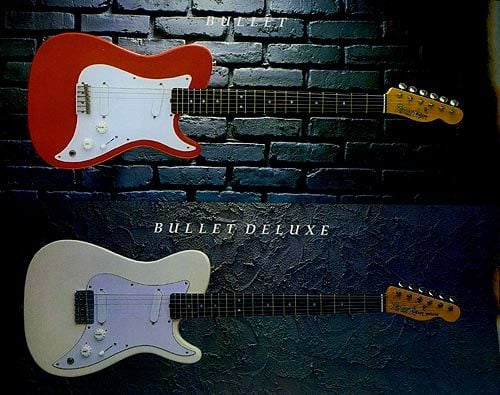Fender Bullet
FROM US FENDER BULLETS TO SQUIER BULLETS


|
Fender initially intended to have the Bullet manufactured offshore in Korea, but it did not work out due to some quality control issues, and the first two models, the Bullet (known as “Standard Bullet”) and the Bullet Deluxe, were made in the USA at the Fullerton plant between 1981 and mid-1982. These guitars were also called “Bullet One” by US dealers and retailers but never marketed as such.
It’s important to keep in mind that at that time, the Bullets were not a type of Stratocaster, but rather, they were a model of their own — similar to the Stratocaster, the Telecaster, the Precision bass, and so on. |
|
The Deluxe model was equipped with a plastic pickguard with a separate, strings-through body hard-tail bridge, while the Standard model featured a powder-coated white or black steel pickguard-bridge-tailpiece combo that had a small lip raised at a 90% angle to anchor the strings, along with separate saddles featuring offset string grooves and height screws.
All Standard pickguards had a “PATENT APPLIED FOR” sticker to protect the design of the pickguard-bridge-tailpiece combo until the patent was granted. |

|
© COPYRIGHT 2014-2024 FUZZFACED.NET BY ANTONIO CALVOSA - TUTTI I DIRITTI RISERVATI
La copia, la riproduzione, la pubblicazione e la redistribuzione dei contenuti, se non autorizzate espressamente dall'autore, sono vietate in qualsiasi modo o forma. |

|
© COPYRIGHT 2014-2024 FUZZFACED.NET BY ANTONIO CALVOSA - ALL RIGHTS RESERVED
The copying, reproduction, publication and redistribution of the contents, unless expressly authorized by the author, are prohibited in any way or form. |